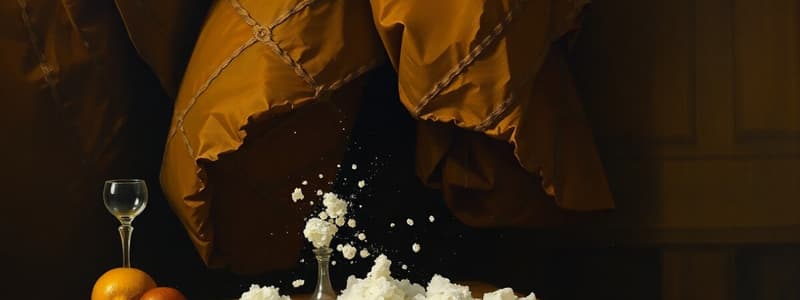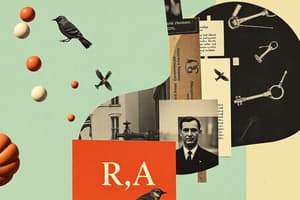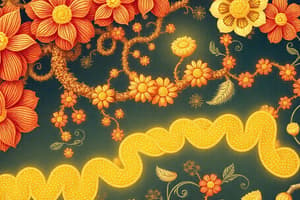Podcast
Questions and Answers
In the human body, what percentage of cholesterol is produced endogenously?
In the human body, what percentage of cholesterol is produced endogenously?
- 85% (correct)
- 15%
- 95%
- 50%
Why is it NOT always necessary for a patient to be in a fasting state when measuring serum cholesterol?
Why is it NOT always necessary for a patient to be in a fasting state when measuring serum cholesterol?
- Cholesterol synthesis is suppressed during fasting.
- Fasting can artificially inflate cholesterol readings.
- Dietary ingestion has a negligible effect on serum cholesterol levels. (correct)
- The cholesterol from dietary ingestion significantly impacts serum cholesterol.
Plant sterols, such as beta-sitosterol, have what effect on cholesterol absorption in humans?
Plant sterols, such as beta-sitosterol, have what effect on cholesterol absorption in humans?
- They are readily absorbed and increase overall sterol levels.
- They have no effect on cholesterol absorption.
- They enhance cholesterol absorption.
- They are poorly absorbed and block the absorption of animal dietary cholesterol. (correct)
Under normal physiological conditions, is cholesterol considered a harmful substance?
Under normal physiological conditions, is cholesterol considered a harmful substance?
In plasma, approximately what proportion of cholesterol is typically esterified?
In plasma, approximately what proportion of cholesterol is typically esterified?
Why must cholesterol associate with specific proteins for transport in the blood?
Why must cholesterol associate with specific proteins for transport in the blood?
In what form is excess cholesterol, beyond the body's immediate needs, primarily eliminated?
In what form is excess cholesterol, beyond the body's immediate needs, primarily eliminated?
What are the primary components of total cholesterol as measured in a clinical setting?
What are the primary components of total cholesterol as measured in a clinical setting?
Which of the following represents the major route of cholesterol excretion from the body?
Which of the following represents the major route of cholesterol excretion from the body?
If a patient consumes a diet very high in cholesterol, what is the expected compensatory response in most individuals?
If a patient consumes a diet very high in cholesterol, what is the expected compensatory response in most individuals?
What percentage of the body's total cholesterol is found within the brain?
What percentage of the body's total cholesterol is found within the brain?
Why does the brain synthesize its own cholesterol rather than obtaining it from the bloodstream?
Why does the brain synthesize its own cholesterol rather than obtaining it from the bloodstream?
Which dietary modification would be MOST effective in lowering undesirable cholesterol levels?
Which dietary modification would be MOST effective in lowering undesirable cholesterol levels?
Compared to muscle meats, how do organ meats generally compare in cholesterol content per serving?
Compared to muscle meats, how do organ meats generally compare in cholesterol content per serving?
What is a primary function of cholesterol within cell membranes?
What is a primary function of cholesterol within cell membranes?
Which class of hormones is synthesized from cholesterol?
Which class of hormones is synthesized from cholesterol?
Where does the majority of cholesterol synthesis occur in the body?
Where does the majority of cholesterol synthesis occur in the body?
What cofactors or reactants are required for cholesterol synthesis?
What cofactors or reactants are required for cholesterol synthesis?
Which of the following is the regulatory enzyme in cholesterol synthesis?
Which of the following is the regulatory enzyme in cholesterol synthesis?
Under what metabolic conditions is cholesterol synthesis stimulated?
Under what metabolic conditions is cholesterol synthesis stimulated?
How do statin drugs lower blood cholesterol levels?
How do statin drugs lower blood cholesterol levels?
Which of the following are considered primary bile acids?
Which of the following are considered primary bile acids?
What enzyme regulates the synthesis of bile acids from cholesterol?
What enzyme regulates the synthesis of bile acids from cholesterol?
Bile acids are conjugated with which two amino acids to form bile salts:
Bile acids are conjugated with which two amino acids to form bile salts:
What is the primary function of conjugating bile acids with amino acids?
What is the primary function of conjugating bile acids with amino acids?
In what part of the body are secondary bile acids produced?
In what part of the body are secondary bile acids produced?
Deoxycholic acid and lithocholic acid are examples of what?
Deoxycholic acid and lithocholic acid are examples of what?
Which best describes enterohepatic circulation?
Which best describes enterohepatic circulation?
What percentage of bile salts entering the duodenum are typically reabsorbed through enterohepatic circulation?
What percentage of bile salts entering the duodenum are typically reabsorbed through enterohepatic circulation?
What is the typical daily secretion volume of bile?
What is the typical daily secretion volume of bile?
What role do bile salts play in the digestion and absorption of fats?
What role do bile salts play in the digestion and absorption of fats?
If a gallstone obstructs the common bile duct, what is a likely consequence?
If a gallstone obstructs the common bile duct, what is a likely consequence?
If a gallstone obstructs the duodenal papilla (of Vater), what is a likely consequence?
If a gallstone obstructs the duodenal papilla (of Vater), what is a likely consequence?
Flashcards
What is cholesterol?
What is cholesterol?
Substance belonging to the sterol group, mainly produced endogenously, with a small fraction derived from the diet.
What is cholesterol?
What is cholesterol?
A sterol in animal tissues that can accumulate in blood vessels in high amounts, disrupting their functions.
What are Lipoproteins?
What are Lipoproteins?
Lipid molecules with attached proteins that transport cholesterol in the blood.
What contributes to the cholesterol pool?
What contributes to the cholesterol pool?
Signup and view all the flashcards
What are the major sources of dietary cholesterol?
What are the major sources of dietary cholesterol?
Signup and view all the flashcards
What Affects Dietary Cholesterol?
What Affects Dietary Cholesterol?
Signup and view all the flashcards
What are functions of cholesterol?
What are functions of cholesterol?
Signup and view all the flashcards
What are the key factors in cholesterol synthesis?
What are the key factors in cholesterol synthesis?
Signup and view all the flashcards
What controls cholesterol synthesis?
What controls cholesterol synthesis?
Signup and view all the flashcards
What regulates Bile acid synthesis
What regulates Bile acid synthesis
Signup and view all the flashcards
What is the function of bile salts?
What is the function of bile salts?
Signup and view all the flashcards
What are primary bile acids?
What are primary bile acids?
Signup and view all the flashcards
What forms bile salts?
What forms bile salts?
Signup and view all the flashcards
What is taurine?
What is taurine?
Signup and view all the flashcards
What are examples of secondary bile acids?
What are examples of secondary bile acids?
Signup and view all the flashcards
What is bile duct?
What is bile duct?
Signup and view all the flashcards
Study Notes
- Presentation is titled "Cholesterol & Bile salts", prepared for 1st-grade MBM module, delivered by Dr. Basil O Saleh & Dr. Maysaa J Majeed on April 8, 2025
Objectives
- Define the cholesterol family and its blood forms
- Illustrate cholesterol homeostasis
- List dietary cholesterol sources
- Briefly describe cholesterol biosynthesis precursors (endogenous pathway)
- Define the regulatory enzyme in cholesterol biosynthesis
- Define the action of cholesterol-lowering drugs from a biochemical perspective
- Group vital compounds derived from cholesterol
- Determine the types & functions of bile salts
Core Clinical Problems (CCPs) 21: Chest Pain
- Mr. Ahmed, 57, has been experiencing chest pain for a couple of months
- He also complains of tightness in his chest
- He is under pressure at work due to an approaching project deadline
- His mother had "bad cholesterol" and died at 65 due to a "heart problem"
- Physical examination reveals that he is slightly pale
- His BP is 140/80 mm Hg and his heart rate is 80/min and irregular
- Blood test results shows low HDL-cholesterol and high LDL-cholesterol
- Other blood parameters are normal
- Following additional tests, Mr. Ahmed was diagnosed with Coronary Artery Disease (Angina Pectoris)
Cholesterol Composition and Origin
- Cholesterol is a soft, fatty substance belonging to the sterol group
- It is mainly produced endogenously (85%)
- A small fraction is derived from diet (15%)
- Serum cholesterol measurement does not require fasting
- Dietary ingestion has a negligible effect on the final result
Cholesterol Importance and Forms
- Cholesterol is a major sterol in animal tissues
- Beta-sitosterol found in plants, it is poorly absorbed by humans and blocks animal dietary cholesterol absorption
- Cholesterol is vital for cell and tissue function, not inherently bad
- High cholesterol levels (hypercholesterolemia) causes accumulation in blood vessels which disrupts function leading to bad lipid consequences
Cholesterol Transport
- Two-thirds of plasma cholesterol is esterified
- Free OH at C3 combines with RCO- of fatty acid RCOOH
- Remainder one-third is free cholesterol, which has free OH at C3
- Free cholesterol (Fch) is more polar (charged) than esterified cholesterol (Ech)
- Both cholesterol types need association with specific proteins to form Lipoprotein compounds to be transported in the blood
- Normal serum or plasma total cholesterol is less than 200 mg/dl
Cholesterol Transport and Excretion
- Cholesterol is carried in the blood by low-density lipoprotein-cholesterol (LDL-C; 2/3) and high-density lipoprotein cholesterol (HDL-C, 1/3)
- The body converts ~50% of amounts of cholesterol beyond the needed into bile acids in the liver, and ~50% is excreted as unmetabolized cholesterol via bile and intestines into feces
- Total cholesterol = Fch + Ech = LDL + HDL + very small amount in VLDL-Cholesterol
Cholesterol Sources and Excretion
- Cholesterol sources arise from diet, hepatic de novo synthesis, and synthesis in extrahepatic tissues
- Cholesterol is then secreted via HDL & VLDL (and so LDL), found as free cholesterol in bile, or converted to bile salts/acids
Dietary Cholesterol Sources
- Egg yolks are the highest source of dietary cholesterol
- Oils high in saturated and trans fats (palm and coconut oils) increase blood cholesterol levels
- Meat and poultry are major sources of cholesterol, with organ meats being higher
- Removing skin from poultry helps reduce cholesterol intake
- Dairy products (cheese, ice cream, milk) are primary sources of saturated fat and cholesterol
- A tablespoon of butter contains 10% of the daily cholesterol value
- A cup of whole milk provides 12% of the daily value
- Commercially prepared baked goods and processed foods are typically high in trans fat, raising LDL and decreasing HDL
- A single doughnut contains 8% of the daily cholesterol value
Dietary Cholesterol Facts
- Animal products like eggs contribute to dietary cholesterol
- About 50% of dietary cholesterol gets absorbed
- Increased cholesterol intake is typically lead to decreased absorption
- On average, 1g/day is excreted as bile acids
Functions of Cholesterol
- It is a membrane component (Fch) of the cell wall and membranes enclosing organelles like the nucleus, mitochondria, endoplasmic reticulum, and Golgi apparatus
- Cholesterol is a precursor to bile acids/salts
- It is a precursor to Vitamin D3
- It is a precursor to steroid hormones, including male & female sex hormones (testosterone, androgens, Estrogens) and adrenal cortex hormones (glucocorticoids like cortisol & mineralocorticoids like aldosterone)
Cholesterol Synthesis
- Occurs in the cytoplasm
- Requires NADPH & ATP
- Highly regulated, HMG-CoA reductase is the regulatory enzyme
- Synthesis occurs 80% in the liver, ~10% in the intestine, and 10% in the brain, skin, adrenal cortex & reproductive tissues
- Precursors are carbohydrates & fatty acids
- HMG-CoA reductase; Hydroxy Methyl Glutaryl-CoA reductase
Cholesterol Synthesis Pathway
- Glucose is converted to Citrate
- Acetyl-CoA is then produced along with Acetate
- Fatty acids are produced together
- Acetoacetate-CoA is produced
- HMG-CoA is the result
- HMG-CoA reductase+NADPH act as a cofactor, turning it into Mevalonate
- Which is then converted to Sequalene
- Final step is Cholesterol creation
HMG-CoA Reductase Regulation
- The regulatory step is at HMG-CoA reductase
- The enzyme and cholesterol synthesis is stimulated post CHO diet & in the presence of insulin
- The opposite occurs in prolonged fasting & presence of glucagon
- Cholesterol synthesis is highly regularized and responsive to changes in cholesterol concentration
- Regulatory mechanism (step of HMG-CoA reductase) balances cholesterol synthesis and excretion
Cholesterol Imbalance
- Imbalance leads to elevated plasma or serum cholesterol (Hypercholesterolemia), associated with coronary artery disease (CAD)
- Patients with hypercholesterolemia are treated with statins (atorvastatin, pravastatin, simvastatin)
- These drugs regulate blood cholesterol levels by inhibiting HMG-CoA reductase, thus stopping the endogenous pathway and controlling blood and body cholesterol
Bile Acids and Salts
- Organic compounds consisting of primary bile acids (cholic and chenodeoxycholic acids), synthesized from cholesterol in the liver
- Cholesterol-7-alpha-hydroxylase is the regulatory enzyme of this pathway
- Cholesterol stimulates it while cholic acid inhibits it
Bile Acid Conjugation and Formation
- Bile acids conjugate with glycine and taurine (derived from cysteine) to form bile salts (more polar, water soluble)
- Bile salts are either secreted into the small intestine/duodenum or stored in the gall bladder
- Intestinal flora in the small intestine converts primary bile acids into secondary bile acids: cholic acid gets turned into deoxycholic acid
- Chenodeoxycholic acid gets turned into lithocholic acid
Bile Salts Function and Action
- Bile salts produced are synthesized in the liver from cholesterol
- Primary bile acids include Cholic acid and Chenodeoxy cholic acid
- Bile acids get conjugated in liver with Taurine & choline
- Cholic Acid + Taurine = Taurocholic Acid
- Cholic Acid + Glycine = Glycocholic acid
- Bile salts aid in fat digestion and absorption
- Intestinal flora removes glycine and taurine from bile salts, regenerating bile acids
- Primary bile acids can be converted into secondary bile acids by removing a hydroxyl group, producing deoxycholic acid from cholic acid and lithocholic acid from chenodeoxycholic acid
Enterohepatic Circulation of Bile Salts
- 90-95% of bile salts that enter the duodenum are reabsorbed back into the portal vein
- The bile salts will return to the liver
- This process is known as Entero Hepatic Circulation of Bile salts
- Remaining 5-10% enters the colon, acted upon by colon bacteria to form Deoxy cholic acid & lithocholic acid
Bile Salt Composition
- Bile salts are the most important components of bile mixture and bile duct (involved in excretion of many substances from the liver like bilirubin & drugs)
- Bile consists of 85% water, 10% bile salts (Cholic, chenodeoxycholic, deoxycholic, and lithocholic acid), mucus, 3% pigments (bilirubin glucuronide), 1% fats (Phospholipids (lecithin), cholesterol) and 0.7% inorganic salts
- It has a daily secretion of 500-1000ml
- It is a transparent alkaline fluid and light yellow in colour
- Its pH: 7.8 – 8.6
Bile Salts Importance and Digestion
- Bile salts are crucial for digestion and absorption of fat (lipid) and fat-soluble vitamins (D, K, A, and E)
- They act as emulsifying agents in the intestine, aiding lipid handling and exposure to pancreatic enzymes
- Bile acids and salts are mechanism for excess cholesterol excretion via the bile duct, small intestine, and ultimately feces
Summary of Cholesterol and Bile Salts
- Cholesterol is a major lipid component, existing as free (hydrophilic) and esterified (hydrophobic) forms
- Mainly produced endogenously, with a small fraction from diet; primarily found in LDL and HDL lipoproteins
- Synthesized mainly in the liver, intestine, and gonads, with HMG-CoA reductase as the regulatory enzyme under feedback control
- Homeostasis involves intestinal excretion and hepatic primary bile acid synthesis
- Bile acids and bile salts are crucial for fat and fat-soluble vitamin digestion and absorption
Case Scenario
- A 45-year-old man with a 5-year history of hypertension presents for biochemical investigations and has serum cholesterol levels of 250 mg/dl
- Discussion points:
- Discuss the physiological importance of cholesterol
- Illustrate the basic points of cholesterol biosynthesis
- Define the types of bile acids and their functions
- Discuss the subtypes of cholesterol in blood
Studying That Suits You
Use AI to generate personalized quizzes and flashcards to suit your learning preferences.




